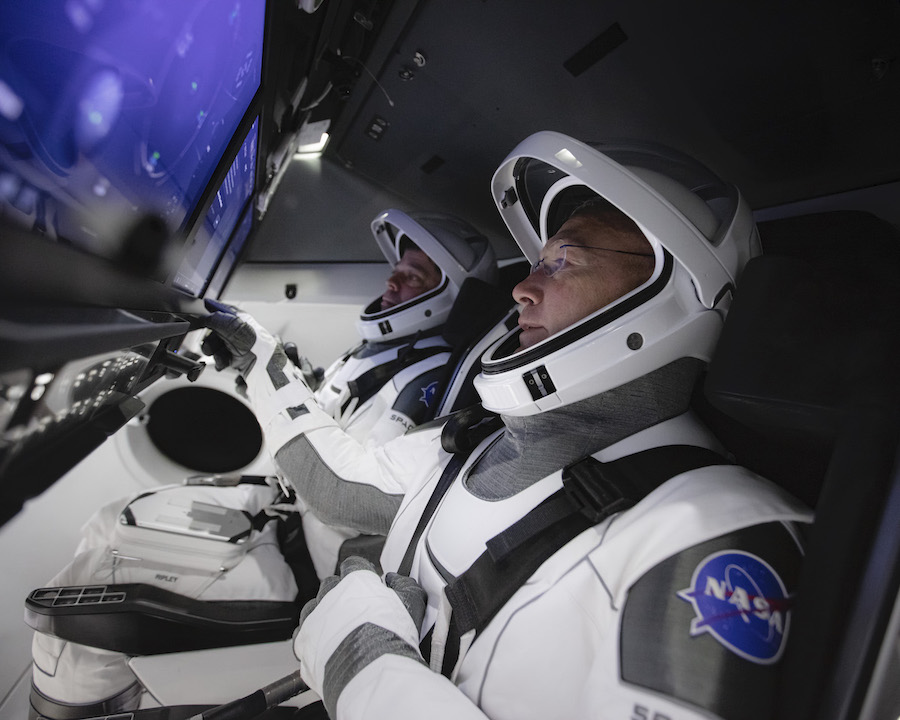The touchscreen controls of SpaceX's Crew Dragon give astronauts a sci-fi way to fly in space
"As a pilot my whole career having a certain way to control a vehicle, this is certainly different."

Veteran NASA astronauts who've flown countless vehicles as test pilots will have to cope with something out of the ordinary with SpaceX's Crew Dragon: touchscreens.
The company's crewed capsule, which is set to launch from NASA's Kennedy Space Center as part of the Demo-2 mission Saturday (May 29), is an autonomous vehicle with a stark, futuristic appearance. But the spacecraft doesn't just look cool, it also employs a number of modern technologies.
Among its many attributes, Crew Dragon features a nearly completely touchscreen-based interface.
Crew Dragon's touchscreen is unlike the control modules of most other spacecraft and aircraft, which typically use manual controls. For NASA astronauts Bob Behnken and Doug Hurley, who most recently flew to space on the shuttle and will be tucked in the capsule for Demo-2, adjusting to the vehicle's touchscreens has been a major part of preparing for the flight.
Related: In photos: SpaceX's Demo-2 Crew Dragon test flight with astronauts
"As a pilot my whole career having a certain way to control a vehicle, this is certainly different," Hurley said during a news conference held on May 1. "But we went into it with a very open mind."
Hurley and Behnken worked with SpaceX to "refine the way that you interface with the touchscreen and the way your touch is actually registered on the display in order to be able to fly it cleanly and not make mistakes touching it," Hurley said.
Get the Space.com Newsletter
Breaking space news, the latest updates on rocket launches, skywatching events and more!
While Hurley and Behnken have had to adjust to the new system because of its differences from the manual controls they're used to, Crew Dragon's touchscreens are a solid system. "It's a little bit different way of doing it but the design, in general, has worked out very well," he said.
There were some initial concerns with making Crew Dragon's controls all touchscreen, Norm Knight, deputy director of NASA Johnson Space Center Flight Operations, said during a news media conference Monday (May 25).
"People wondered, 'How are these going to work? How can you have control of the vehicle with these things? Are they going to be reliable?'" Knight said.
But, despite early hesitation about a touchscreen system, SpaceX worked with the astronauts to create an interface that was both reliable and worked well for the crew, who would be actually using the touchscreen.
"There was a lot of testing and evaluation that went into the ergonomics of the placement of what's on the displays, how those displays are presented to the crew," Knight said.
In addition to having touchscreen controls, Crew Dragon is also an autonomous vehicle. However, the crew can put the spacecraft into a "manual mode" and control it directly, whether they are trying to dock with the space station, land back on Earth or even abort a launch and return to the ground.
During the Demo-2 mission, Behnken and Hurley will not only test Crew Dragon's typical capabilities, Hurley will also fly the vehicle manually twice to ensure that the spacecraft's controls work correctly.
- SpaceX's Crew Dragon space capsule explained (infographic)
- SpaceX celebrates Crew Dragon's 1st launch anniversary with epic video
- See the evolution of SpaceX's rockets in pictures
Follow Chelsea Gohd on Twitter @chelsea_gohd. Follow us on Twitter @Spacedotcom and on Facebook.
OFFER: Save 45% on 'All About Space' 'How it Works' and 'All About History'!
For a limited time, you can take out a digital subscription to any of our best-selling science magazines for just $2.38 per month, or 45% off the standard price for the first three months.
Join our Space Forums to keep talking space on the latest missions, night sky and more! And if you have a news tip, correction or comment, let us know at: community@space.com.

Chelsea “Foxanne” Gohd joined Space.com in 2018 and is now a Senior Writer, writing about everything from climate change to planetary science and human spaceflight in both articles and on-camera in videos. With a degree in Public Health and biological sciences, Chelsea has written and worked for institutions including the American Museum of Natural History, Scientific American, Discover Magazine Blog, Astronomy Magazine and Live Science. When not writing, editing or filming something space-y, Chelsea "Foxanne" Gohd is writing music and performing as Foxanne, even launching a song to space in 2021 with Inspiration4. You can follow her on Twitter @chelsea_gohd and @foxannemusic.










